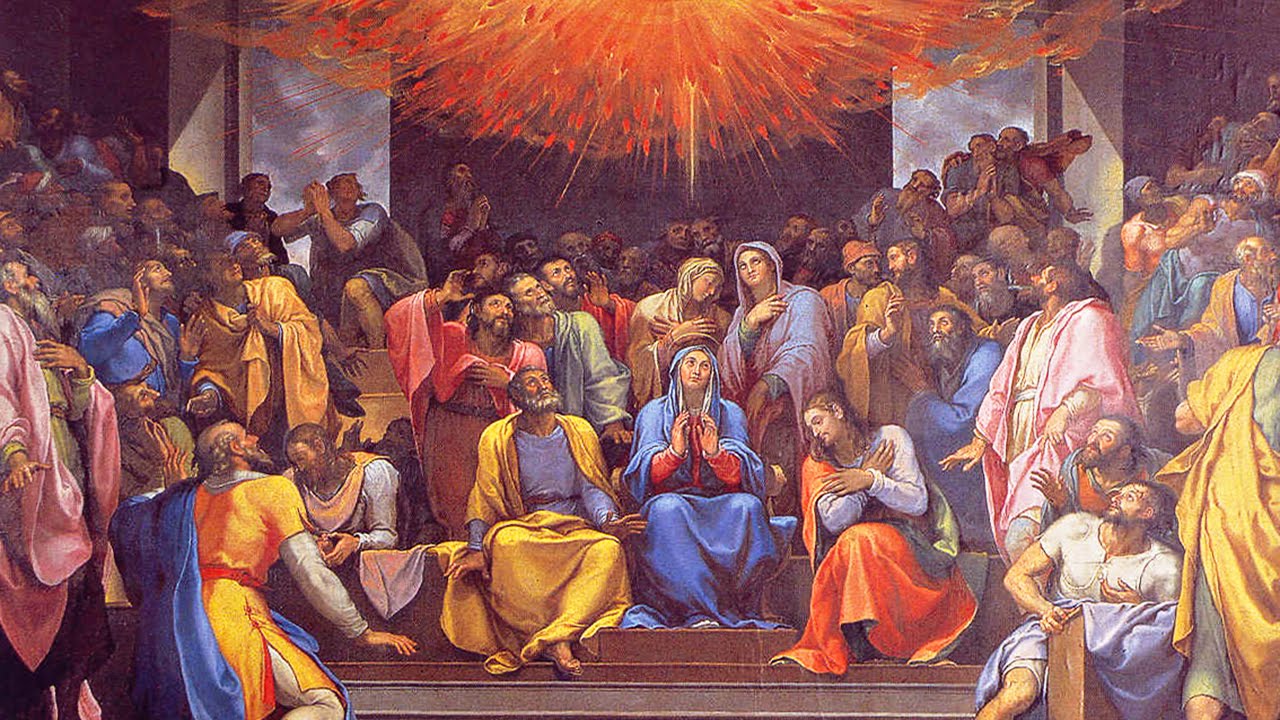
Scripture (Acts 1: 12-14)
12 The apostles returned to Jerusalem from the mountain called Olivet, which is near Jerusalem, a Sabbath day’s journey away. 13 When they had come in, they went up into the upper room where they were staying, that is Peter, John, James, Andrew, Philip, Thomas, Bartholomew, Matthew, James the son of Alphaeus, Simon the Zealot, and Judas the son of James. 14 All these with one accord continued steadfastly in prayer and supplication, along with the women and Mary the mother of Jesus, and with his brothers.
Meditation
Among the various means by which the Holy Spirit implements His work of sanctification in the Church – the Word of God, the Sacraments, prayer – there is one in entirely particular, and it is Marian piety. In the Catholic tradition there is this motto, this saying: “ Ad Iesum per Mariam”, that is, “to Jesus by means of Mary”. Our Lady lets us see Jesus. She opens the doors to us, always! Our Lady is the mother who leads us by the hand towards Jesus. Our Lady never points to herself, Our Lady points to Jesus. And this is Marian piety: to Jesus by the hands of Our Lady. The true and only mediator between us and Christ, indicated as such by Jesus Himself, is the Holy Spirit. Mary is one of the means the Holy Spirit uses to bring us to Jesus. Saint Paul defines the Christian community as “a letter of Christ administered by us, written not in ink but by the Spirit of the living God, not on tablets of stone but on tablets that are hearts of flesh” (2 Cor ;3:3). Mary, as the first disciple and figure of the Church, is also a letter written with the Spirit of the living God. Precisely for this reason, she can be “known and read by all” (2 Cor 3:2), even those who do not know how to read theology books, those “little ones” to whom Jesus says that the mysteries of the Kingdom, hidden to the wise, are revealed (cf. Mt 11:25). By saying her “Yes” – when Mary accepts and says to the Angel, “Yes, let the Lord’s will be done” and accepts to be the mother of Jesus – it is as though Mary said to God: “Here I am, I am a tablet to be written on: let the Writer write what he wants, make of me what the Lord of all wishes”. At that time, people wrote on waxed tablets; today we would say that Mary offers herself like a blank page on which the Lord can write whatever He wants. Mary’s “Yes” to the Angel – as a renowned exegete wrote – represents “the apex of all religious behaviour before God, since she expresses, in the highest manner, passive availability combined with active readiness, the deepest emptiness that accompanies the greatest fullness”. This, then, is how the Mother of God is an instrument of the Holy Spirit in His work of sanctification. In the midst of the endless profusion of words said and written about God, the Church and holiness (that very few, or no-one, is able to read and understand fully), she suggests a few words that everyone, even the simplest, can say on any occasion: “behold” and “let it be done”. Mary is the one who said “Yes” to the Lord, and with her example and by her intercession urges us to say our “Yes” to Him too, whenever we are faced with an act of obedience to perform or a trial to overcome. In every age of our history, but in particular at this time, the Church finds herself in the same situation as the Christian community in the aftermath of Jesus’ Ascension to heaven. It had to preach the Gospel to all nations, but was awaiting the “power from on high” in order to be able to do it. And let us not forget that, at that time, as we read in the Acts of the Apostles, the disciples were gathered around “Mary the mother of Jesus” (Acts 1:14). It is true that there were also other women together with her in the Upper Room, but her presence is different and unique among them all. Between her and the Holy Spirit there is a unique and eternally indestructible bond that is the very person of Christ Himself, “who was conceived of the Holy Spirit and born of the Virgin Mary”, as we recite in the Creed. The evangelist Luke deliberately highlights the correlation between the coming of the Holy Spirit upon Mary in the Annunciation and His coming to the disciples at Pentecost, using some identical expressions in both cases. (November 13, 2024)
Musical Selection
Collect